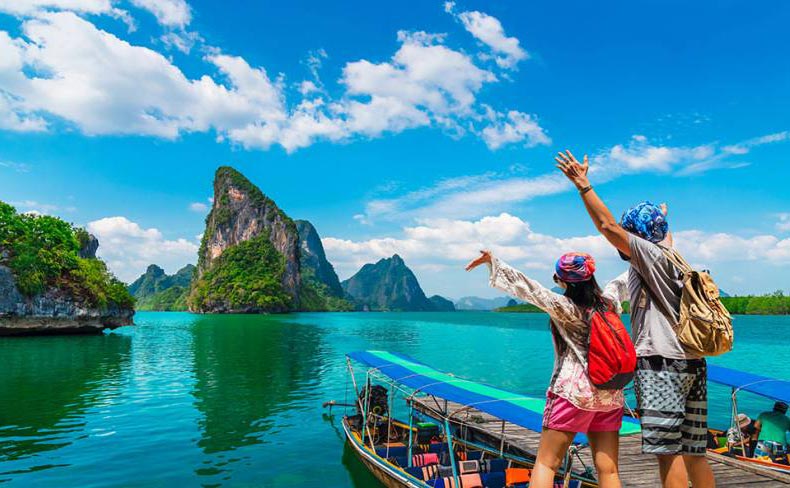
How To Book Your Holiday
- Fill the Form & Get Free Quote
- Our Team Help You To Offer Best Trip
- Proceed Booking Amount For Confirm The Tour
- Get Confirmation Booking Voucher
- Enjoy Your Holidays

The Andaman and Nicobar Islands, situated in the Bay of Bengal, are a treasure trove of natural beauty and cultural heritage. Apart from their pristine beaches, lush rainforests, and vibrant marine life, these islands also hold a rich historical legacy that is often overshadowed by their scenic charm. The monuments and museums scattered across this archipelago offer visitors a glimpse into the region's tumultuous past, showcasing the fusion of cultures, struggles for independence, and the intriguing history of the indigenous tribes. In this article, we will embark on a journey through the monuments and museums of Andaman and Nicobar Islands to discover the stories they hold.
I. Cellular Jail - Port Blair
The Cellular Jail, also known as K?l? P?n? (Black Water), is arguably the most iconic historical monument in the Andaman and Nicobar Islands. This colossal structure, constructed by the British in the late 19th century, served as a notorious colonial prison for Indian political prisoners. The jail complex consists of seven wings radiating from a central watchtower, representing the spokes of a bicycle wheel. The architecture itself carries a symbolism of isolation and oppression.
Within the walls of Cellular Jail, visitors can explore a museum that narrates the tales of India's freedom struggle, shedding light on the inhumane treatment of prisoners and the sacrifices made by those who fought for independence. The 'Sound and Light Show' held in the evenings takes visitors on an emotional journey through the hardships endured by the inmates.
II. Ross Island - Port Blair
Ross Island, once the administrative headquarters of the British in the Andaman and Nicobar Islands, is a living testament to the colonial past. It's home to several historical ruins, including a church, bungalows, a bakery, and a British-era hospital. The island's tranquil atmosphere and the haunting beauty of the dilapidated structures evoke a sense of nostalgia and reflection on the bygone era.
Visitors can explore the 'Netaji Subhas Chandra Bose Island,' dedicated to the memory of the iconic freedom fighter. The island features a museum showcasing photographs and artifacts related to the life and times of Netaji Bose.
III. Anthropological Museum - Port Blair
The Anthropological Museum in Port Blair is a must-visit for those curious about the indigenous tribes of the Andaman and Nicobar Islands. The museum's extensive collection includes tools, weapons, photographs, and lifestyle artifacts of the various tribes that call these islands home. It offers a glimpse into the rich cultural diversity and traditions of the native populations, such as the Jarawas, Sentinelese, and Great Andamanese.
IV. Forest Museum - Chidiya Tapu
The Forest Museum at Chidiya Tapu, approximately 25 kilometers from Port Blair, is a hidden gem for nature enthusiasts. This museum showcases a diverse range of exhibits, from the endemic flora and fauna of the islands to information on the coral reefs and marine life. It's an educational experience for those interested in the region's unique biodiversity.
V. Samudrika Marine Museum - Port Blair
The Samudrika Marine Museum, managed by the Indian Navy, is dedicated to the marine life of the Andaman and Nicobar Islands. This museum is home to an extensive collection of marine specimens, including shells, corals, and a variety of fish species. The museum also offers valuable insights into the geography and ecology of the islands.
VI. Zonal Anthropological Museum - Port Blair
The Zonal Anthropological Museum is another remarkable institution in Port Blair that focuses on the indigenous people of the Andaman and Nicobar Islands. It houses an impressive array of ethnographic artifacts, tools, photographs, and models that provide in-depth information about the region's tribes and their unique ways of life.
VII. Japanese Bunkers - Port Blair
Scattered across the islands are remnants of World War II, a time when the Andaman and Nicobar Islands were occupied by the Japanese. Japanese bunkers and fortifications can be found at various locations, bearing witness to the wartime history of the archipelago.
VIII. Fisheries Museum - Port Blair
The Fisheries Museum, operated by the Central Marine Fisheries Research Institute (CMFRI), offers an enlightening experience for visitors interested in marine biology and fisheries. The museum showcases a wide range of aquatic life, including a plethora of fish species, shells, and other marine specimens. It's an engaging stop for those curious about the underwater world surrounding the islands.
IX. Mahatma Gandhi Marine National Park - Wandoor
While not a museum in the traditional sense, the Mahatma Gandhi Marine National Park in Wandoor is a living museum of coral reefs and marine life. Visitors can explore the vibrant underwater world through glass-bottom boat rides or snorkeling. The park houses a wealth of marine species and coral formations, making it a paradise for marine enthusiasts and nature lovers.
X. Cuthbert Bay Wildlife Sanctuary - Little Andaman
This wildlife sanctuary on Little Andaman Island is a haven for wildlife enthusiasts. It is home to one of the most significant nesting populations of the Leatherback sea turtle, an endangered species. The sanctuary aims to conserve the nesting sites of these incredible creatures. Visitors can witness the conservation efforts and the magnificent natural beauty of the sanctuary.
Conclusion
The Andaman and Nicobar Islands, with their abundant natural beauty, also offer a compelling narrative of history and culture. The monuments and museums across these islands serve as windows to the past, revealing stories of colonial rule, the struggle for independence, and the intriguing lives of the indigenous tribes. Exploring these sites not only enriches one's knowledge but also fosters a deeper appreciation for the unique heritage and biodiversity of the region. A journey through the monuments and museums of the Andaman and Nicobar Islands is a voyage through time and nature, leaving an indelible mark on the traveler's heart and soul.
